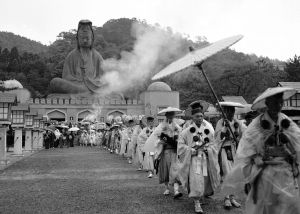Religion
Religion comprises beliefs about the divine and the supernatural, and the social structures for expressing and practicing them. There are many religions in the world, and of these, the most sophisticated are the triad of Messenian civilisation—Cairony, Siriash and subsequently Arlatur—and the Joriscian system of Vaestism.
Modern religions
Civilised religions
The commonly acknowledged civilised religions are as follows:
- Arlatur, the effective ethnic religion of the Siur people, teaches the cultivation of internal holiness, neisti, and its reunification with the Absolute, einingu, through world-improving works that enable a consciously experienced unity. It emerged from the ideas of Siur savant and philosopher Ragna Hrafnamaður in the early seventh century.
- Cairony, dominant creed of northern Messenia and its sphere of influence, teaches that the world is created by Aedif, composed of Cairon, and damaged by the cosmic war known as the Great Upheaval between Aedif and the Comegenes against the Odiosi. In exchange for Aedif's Divine Indulgence, humans partake in Restoration of Cairon and the world to repair the universe into its originally perfect state, through practices such as Cairon Engineering. It gradually evolved from the old Senuminist pantheon of the Sabāmani people, starting under the Six Holy Sisters in the 8th century BCE, and brought to a climax under the auspices of the Glorious Prophetess at the beginning of the Cairan Era.
- Siriash, dominant creed of southern Messenia and its sphere of influence, northern and eastern Lestria, and Petty-Lestria, follows the path laid out by Nevaras for humans to Ascend and reclaim their suppressed nature as the godly beings known as Asmedons, while avoiding further degeneration by transgressions which leads to Descension. The Ascended then join Nevaras in the Siege of Archtum against the Sebanants, who took away human powers in the Arayan and now feed off the spiritual corruption of mortals. It appeared in the 6th century BCE as a drastic revision of Palthachist practices in the region inhabited by the Antissan culture, gradually spreading as one of the world's first known complex philosophical schools and universalistic religions across two continents.
- Vaestism, dominant in Outer Joriscia and its sphere of influence, teaches that the world is balanced between the infinite realms of Light and Dark, and that it is incumbent upon humans to gain and regiment Knowledge so that they might transcend this cosmic struggle through their regulated will. Given that the world is eventually bound for destruction (execration), and that failure to transcend renders one's work to have been done in vain through shattering reincarnation, the correct transmission and cultivation of Knowledge becomes critical. It was founded on the teachings of the Prophet, whose work bridged the 14th and 15th centuries, growing out of an Outer Joriscia dominated by Siriash and post-Chotarian Ishtinism.
Characteristics
The categorisation of 'civilised religions' is obviously connected to the idea of civilisation, not just by their association with the Civilised World and its Great Powers but also by how they clearly, consciously, and systematically govern their respective societies. Ceresoran scholar Augusto Grolli defined a civilised religion based on three interconnected features:
- Forms a complete worldview with universal applicability, particularly one which rationally internalises and explains everything in its terms as a science;
- Exclusive in its conception, does not easily accommodate or syncretise with other religions;
- Holds distinctive and significant role in practitioners' lives through institutions, which measure life itself in its terms.
These characteristics make the religion the core of a civilisation by effectively governing and justifying every aspect of its culture. Definitions of civilised religion and civilisation have fed into each other, and the type of civilisation governed by a civilised religion is known as a 'religious civilisation'.
The Grollian criteria are still disputed, and they have not consistently applied to any of the main recognised civilised religions: claims to a self-sufficient yet all-explaining worldview among the Messenian triad, for example, is hampered by the fact a great deal of natural science is derived from translationism, while major syntheses like Cairo-Sirian syncretism have survived well into the present. Furthermore, as later critics of the idea have argued, their basis on Messeno-Joriscian norms have limited the paradigm's usefulness in dealing with other religious traditions. Besides the considerable Vaestic influence on the idea of civilised religions, a view of the civilising turn, as simply separate schools and vocations in a wider shared 'Messenian religion' becoming more exclusive due to the Partition of Messenia, has also led to criticism of the applicability of the model.
Developed religions
The criteria for developed religions are fuzzier but no less contentious. The general consensus is that they have many sophisticated features such as detailed scriptures and philosophies, or complex and powerful institutions, but lack some other Grollian criterion to attain a depth comparable to the civilised religions. More straightforwardly, they are associated with peripheral regions at political and economic mercy of the Civilised World, limiting both their influence and the acceptance of which by classifiers of religion.
- Bhramavada is a group of traditions found across Ascesia centred on the concept of a mahanasatya or "universal truth", of which the physical world inhabited by human beings is considered to be a vague reflection. The first codified forms of Bhramavada, and with it the shared features of most of its later variants, were spread out from eastern Adorac by the Serovite Empire in the late 1st millennium BCE, but similar themes are found in folk religions of Ascesian peoples who have received little of Serovite influence. Political exigencies notwithstanding, most forms of Bhramavada are highly syncretistic and never exclusive, even actively seeking other traditions to combine with, which has limited appraisal of its civilisation among Messenians. Conversion efforts by Messenians and Vesnites have weakened its hold significantly, and called its wider social order into question. Arguments have been made for certain branches, such as Rattharvism, to be classified as 'semi-civilised' religions.
- Pyranism is another multifarious religion, revolving around a deistic creator Abban, the opposing and more active divinities of the Lord and Lady (along with their aspects), and the idea that material life precedes and informs a judgement by Abban known as loycren that determines fitness to enter the next life, known as Toccay. Pyranists engage in physical and spiritual self-improvement known as siulen, take part in heroic challenges and adventures, and manipulate or appeal to local divinities for favour, all to demonstrate and build on their worthiness. Pyranism in its various forms prevails along the Pyranist belt that stretches from southern Lestria, through the western Lestrian coast where its philosophies emerged, to southeastern Ascesia. Its communities have syncretised with many of the civilised religions enthusiastically.
- Tondakan religion comprises the diverse practices of southeastern Lestria associated with the inhabitants of the Tondaku, and their cultural sphere of influence.
Ancient religions
- Ishtinism was a widespread religion in south-eastern Outer Joriscia, unusual for its belief in the existence of a single god, Ishtin, and closely associated with the Chotarian civilisation. It became particularly important in the legitimation of the Chotarian Emperor. After the Secote conquest of Outer Joriscia, Ishtinism initially retreated, then experienced a revival in the form of the Second Dawn, but was finally extinguished by the rise of Vaestism. Certain Ishtinist rituals were carried over into Vaestic practice.
- Undughu religion was practiced by the Undughu civilisation. Initially a diffuse set of practices and factions related to the appeasement of natural spirits, under the Undughu Empire an Ishtinist-style imperial cult, new cultures based around figures that celebrated rational imagination such as hynah, and philosophy regarding disclosure upended old ideas of devotion. After Secote conquest, and the later rise of Vaestism, elements of these traditions survived into northeastern Joriscian folk religion.
- Ancient Messenia was dominated by a more nebulous spectrum of religious practices, in which some distinct pantheons and ways to worship them, qualifying as distinct cultures, existed alongside a general theme of enhieronism as expressed in traditional wisdom. Some examples are as:
- Palthachism was the pantheon of the Antissan culture of southern Messenia. It was weakened by natural and political crises in the 1st millennium BCE, and wiped out by Siriash.
- Senuminism was the pantheon of the Sabamāni people, and was reformed and reorganised into Cairony.
- Thúrun was the pantheon of far western Messenia, with a greater tendency towards animism than the others. It was overturned and absorbed by Arlatur.
- Pisticism was a group of polytheistic practices which were dominant in Carcharia and Tarsh, eventually displaced by Siriash over the course of the 1st millennium.

